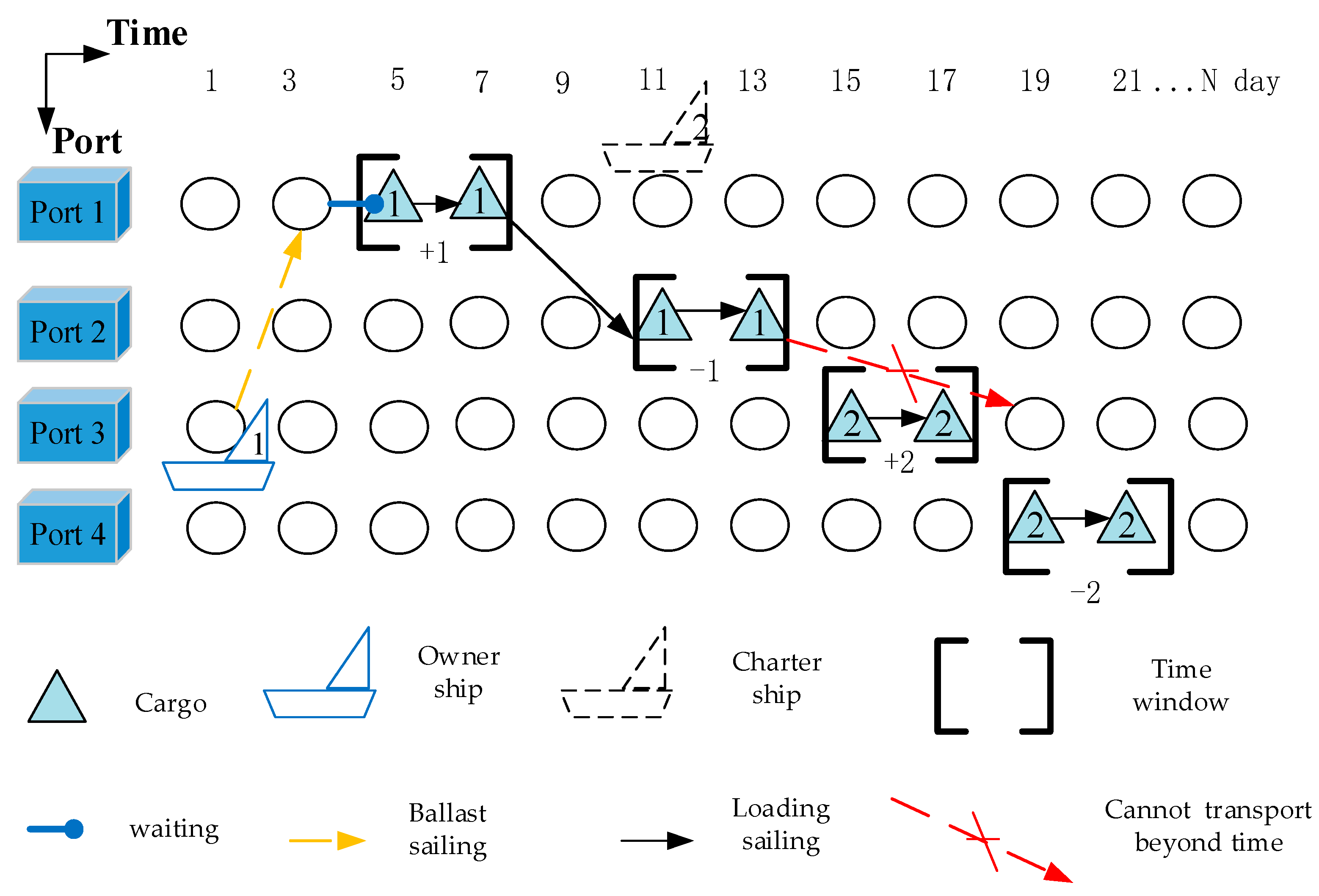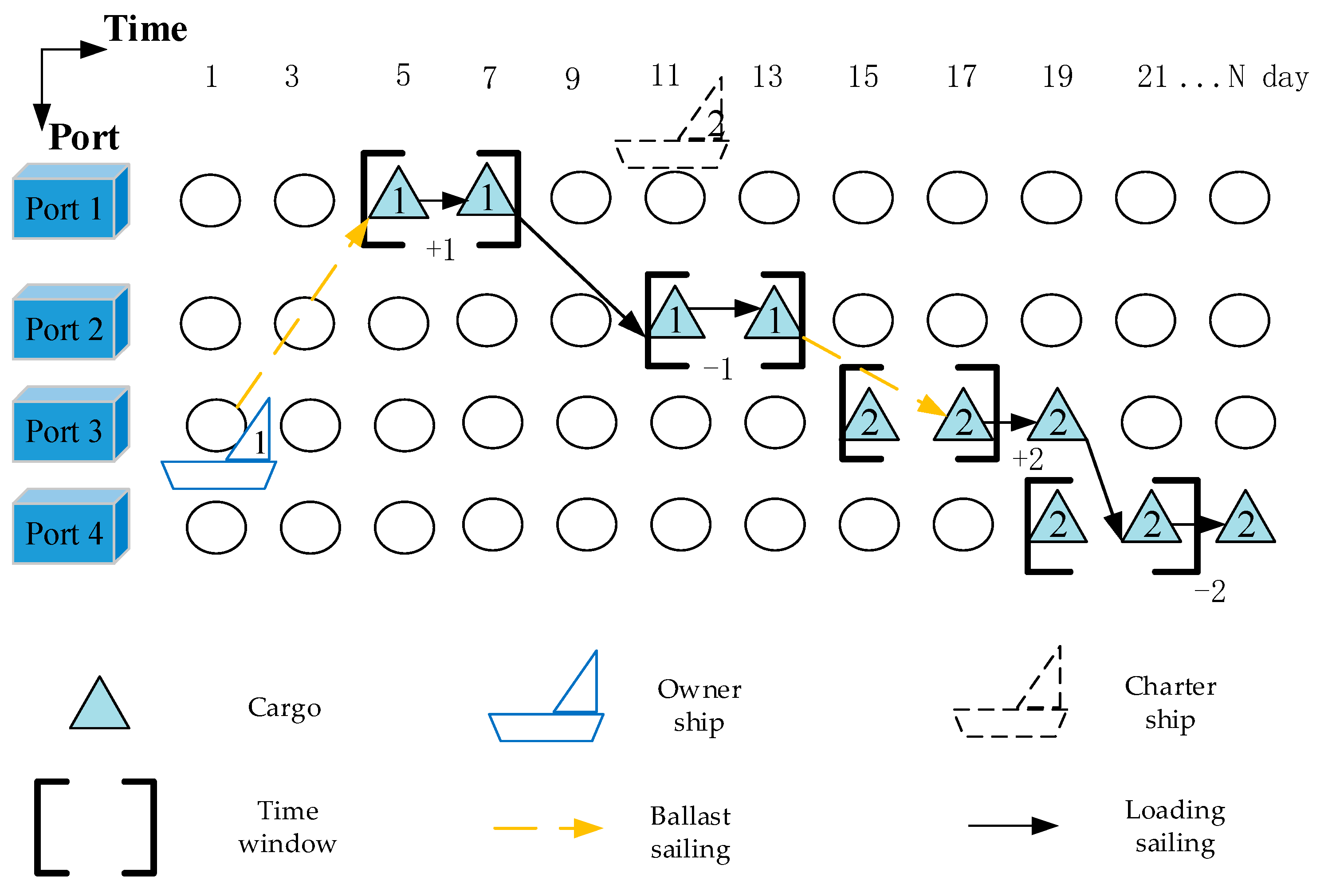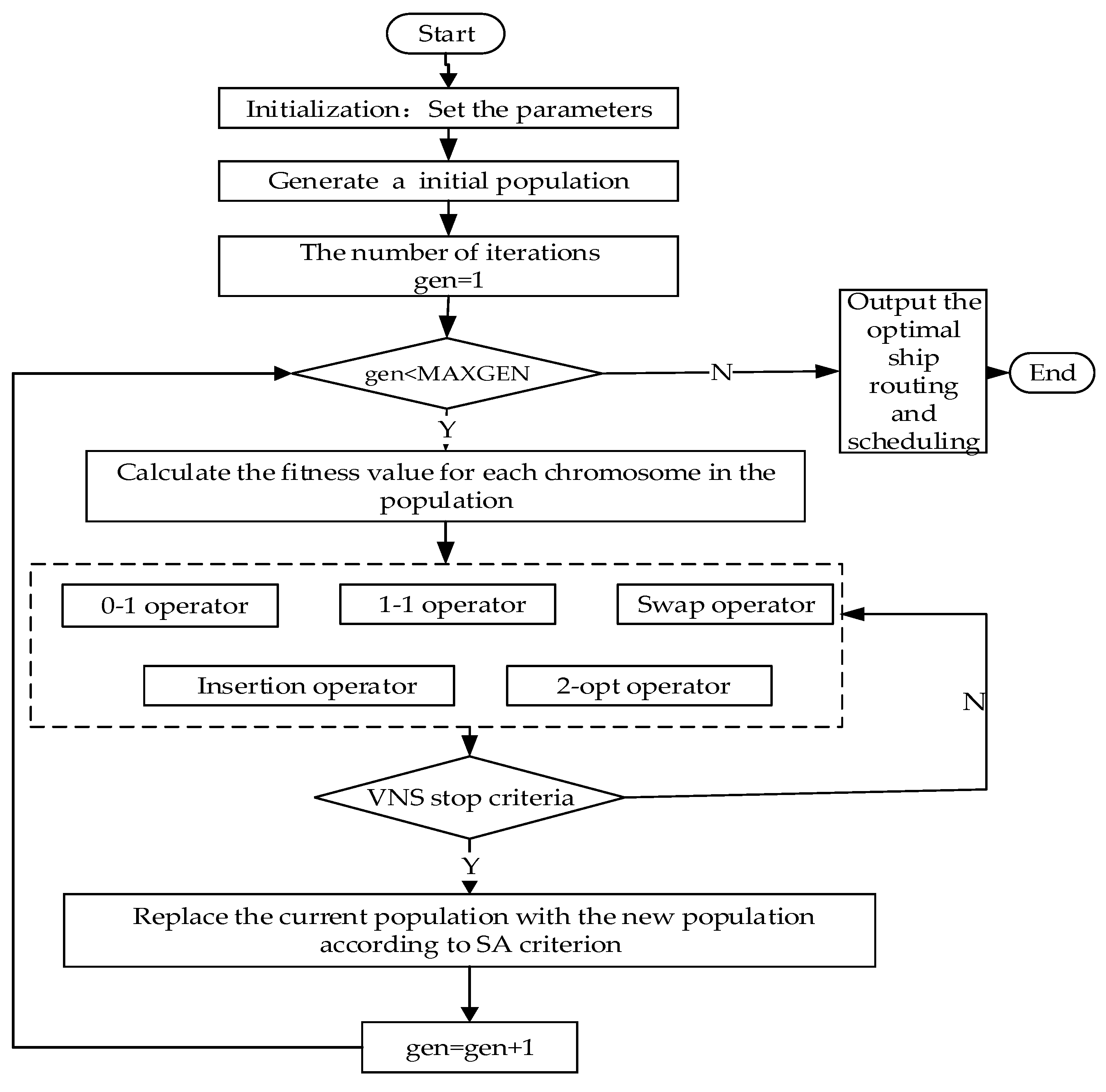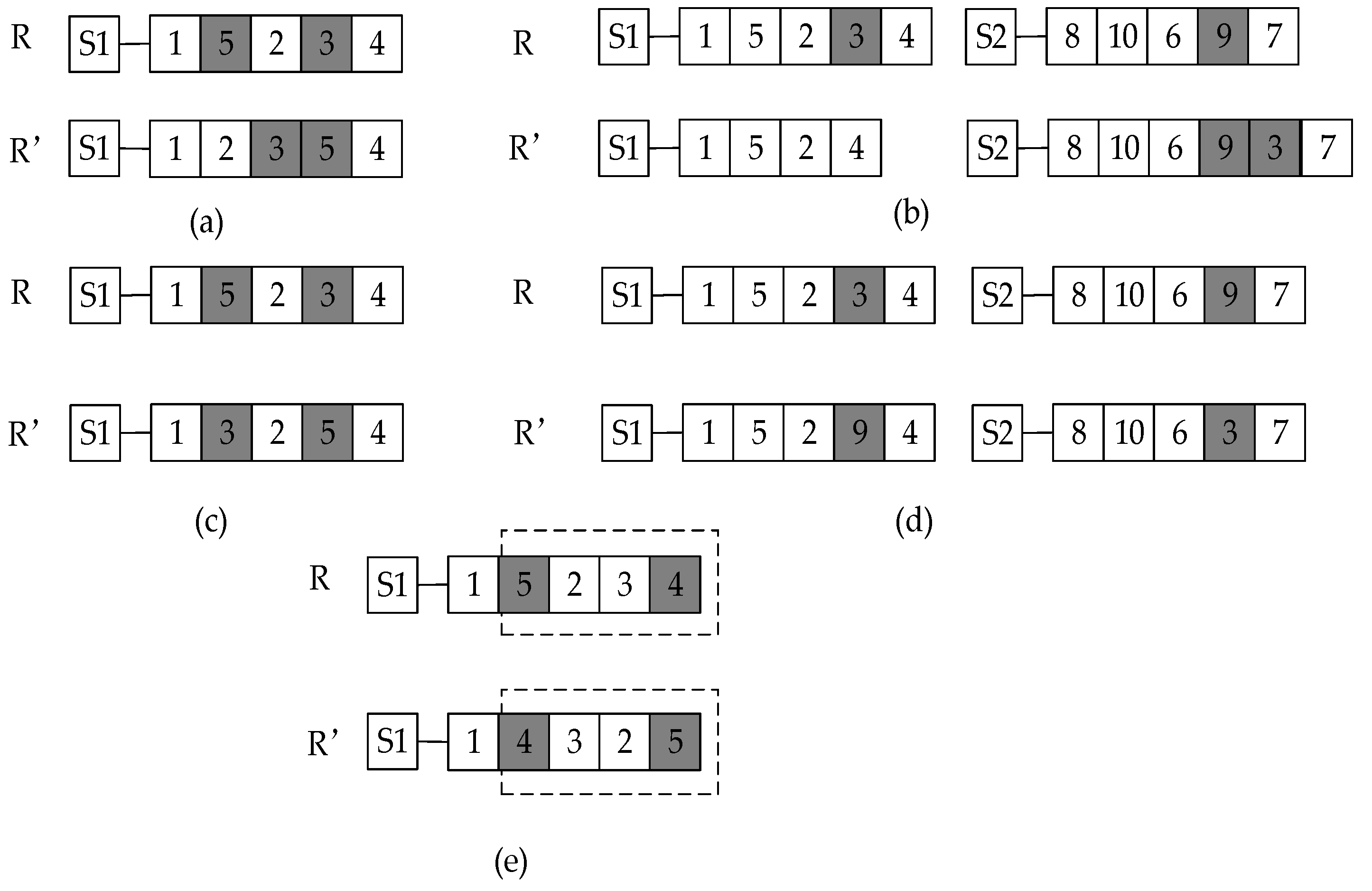Tramp Ship Routing and Scheduling with Speed Optimization Considering Carbon Emissions
Abstract
1. Introduction
2. Literature Review
2.1. Tramp Ship Routing and Scheduling Models and Methods
2.2. Speed Optimization
2.3. Carbon Emissions Consideration
3. Problem Description and Mathematical Model
3.1. Problem Description
3.2. Model Assumptions
- (1)
- The shipping company has a fleet of heterogeneous ships, which have their own attributes such as capacity, cruising speed, draft, and other parameters.
- (2)
- For transporting cargo, the shipping company is allowed to choose its owner ships or charter ships in the spot market.
- (3)
- Each cargo has a specific weight, loading port and discharging port, and time window. This information is known in advance. Cargoes cannot be split and should be picked up by exactly one ship during one visit. However, the ships are allowed to make multiple visits to a port if this is necessary.
- (4)
- Each ship is initially located at a given port and shall not return to the initial port after completing a voyage. A ship can sail at different speeds on different legs of the route as long as the speeds are within its feasible speed range.
- (5)
- Fuel price does not change over time.
3.3. Fuel Cost and Carbon Emissions Tax
3.4. Notation Used in the Model
3.5. Mathematical Model
4. Solution Method
4.1. Encoding and Initial Feasible Solution
4.2. Calculate Fitness
4.3. Variable Neighborhood Search Strategy
- (1)
- The 0–1 exchanged operator selects two points from a route randomly and tries to insert one point after the other point within the same route. Figure 4a shows an example where customer 5 and customer 3 are selected, we can insert customer 5 after customer 3 in R’.
- (2)
- The insertion operator chooses cargo from a route and from other routes randomly, deletes the cargo from a route, and inserts it into another route. Figure 4b shows an example where customer 3 on the S1 and customer 9 on the S2 are selected, we can insert customer 3 after customer 9 in R’.
- (3)
- The 1–1 exchanged operator selects two points from a route randomly and exchanges them. Figure 4c shows an example where customer 5 and customer 3 are selected, and we can relocate customer 5 and customer 3.
- (4)
- The swap operator selects a contract from a route, and another contract from another route, and swaps them. Figure 4d shows an example where customer 3 and customer 9 are selected, we can swap customer 3 and customer 9 in R’.
- (5)
- The 2-opt operator chooses two points on route R randomly and reverses between the two points. The process is shown in Figure 4e, an exchange between customer 4 and customer 5.
4.4. Update Solution
5. Discussion
5.1. Numerical Example
5.2. Computational Performance
5.3. Calculation of Examples
5.3.1. Multiple Optimal Speeds versus a Single Optimal Speed
5.3.2. Results under Different Objective Functions
5.4. Sensitivity Analysis
5.4.1. Fuel Price
5.4.2. Carbon Emissions Taxation Strategy
6. Conclusions
Author Contributions
Funding
Acknowledgments
Conflicts of Interest
References
- International Maritime Organization. Third IMO Greenhouse Gas Study 2014; IMO: London, UK, 2014. [Google Scholar]
- Buhaug, Ø.; Corbett, J.J.; Endresen, Ø.; Eyring, V.; Faber, J.; Hanayama, S.; Lee, D.S.; Lee, D.; Lindstad, H.; Markowska, A.Z.; et al. Second IMO GHG Study; International Maritime Organization (IMO): London, UK, 2009. [Google Scholar]
- Thai, V.V.; Tay, W.J.; Tan, R.; Lai, A. Defining Service Quality in Tramp Shipping: Conceptual Model and Empirical Evidence. AJSL 2014, 30, 1–9. [Google Scholar] [CrossRef]
- De Armas, J.; Lalla-Ruiz, E.; Expósito-Izquierdo, C.; Landa-Silva, D.; Melián-Batista, B. A hybrid GRASP-VNS for ship routing and scheduling problem with discretized time windows. Eng. Appl. Artif. Intell. 2015, 45, 350–360. [Google Scholar] [CrossRef]
- Hennig, F.; Nygreen, B.; Furman, K.C.; Song, J. Alternative approaches to the crude oil tanker routing and scheduling problem with split pickup and split delivery. Eur. J. Oper. Res. 2015, 243, 41–51. [Google Scholar] [CrossRef]
- Lee, J.; Kim, B.I. Industrial ship routing problem with split delivery and two types of vessels. Exp. Syst. Appl. 2015, 42, 9012–9023. [Google Scholar] [CrossRef]
- Hemmati, A.; Hvattum, L.M.; Fagerholt, K.; Norstad, I. Benchmark Suite for Industrial and Tramp Ship Routing and Scheduling Problems. INFOR 2014, 52, 28–38. [Google Scholar] [CrossRef][Green Version]
- Hemmati, A.; Stalhane, M.; Hvattum, L.M.; Andersson, H. An effective heuristic for solving a combined cargo and inventory routing problem in tramp shipping. Comput. Oper. Res. 2015, 64, 274–282. [Google Scholar] [CrossRef]
- Siddiqui, A.W.; Verma, M. A bi-objective approach to routing and scheduling maritime transportation of crude oil. Transp. Res. Part D Transp. Environ. 2015, 37, 65–78. [Google Scholar] [CrossRef]
- Wu, L.X.; Pan, K.; Wang, S.; Yang, D. Bulk ship scheduling in industrial shipping with stochastic backhaul canvassing demand. Transp. Res. Part B. 2018, 117, 117–136. [Google Scholar] [CrossRef]
- Norstad, I.; Fagerholt, K.; Laporte, G. Tramp ship routing and scheduling with speed optimization. Transp. Res. Part C Emerg. Technol. 2011, 19, 853–865. [Google Scholar] [CrossRef]
- Hvattum, L.M.; Norstad, I.; Fagerholt, K.; Laporte, G. Analysis of an exact algorithm for the vessel speed optimization problem. Networks 2013, 62, 132–135. [Google Scholar] [CrossRef]
- Meng, Q.; Wang, S.A.; Chung, Y.L. A tailored branch-and-price approach for a joint tramp ship routing and bunkering problem. Transp. Res. Part B Methodol. 2015, 72, 1–19. [Google Scholar] [CrossRef]
- De, A.; Wang, J.; Tiwari, M.K. Fuel Bunker Management Strategies Within Sustainable Container Shipping Operation Considering Disruption and Recovery Policies. IEEE Trans. Eng. Manag. 2019, 1–23. [Google Scholar] [CrossRef]
- De, A.; Wang, J.; Tiwari, M.K. Hybridizing basic variable neighborhood search with particle swarm optimization for solving sustainable ship routing and bunker management problem. IEEE Trans. Intell. Transp. Syst. 2019, 1–12. [Google Scholar] [CrossRef]
- Li, X.J.; Xie, X.L. Integrated optimization of cargo distribution and ship speed for Heavy-Cargo transportation. J. Southwest Jiao Tong Univ. 2015, 50, 747–754. [Google Scholar]
- Li, Z.; Pan, X.M. Research on optimization algorithm of ship speed. Ship Sci. Technol. 2016, 38, 7–9. [Google Scholar]
- Wen, M.; Ropke, S.; Petersen, H.L.; Larsen, R.; Madsen, O.B.G. Full-shipload tramp ship routing and scheduling with variable speeds. Comput. Oper. Res. 2016, 70, 1–8. [Google Scholar] [CrossRef]
- Yu, C.; Wang, Z.H.; Gao, P. Speed optimization considering dispatch and demurrage of the tramp shipping. J. Transp. Syst. Eng. Inform. Technol. 2018, 18, 195–201. [Google Scholar]
- Psaraftis, H.N.; Kontovas, C.A. Speed models for energy-efficient maritime transportation: A taxonomy and survey. Transp. Res. Part C Emerg. Technol. 2013, 26, 331–351. [Google Scholar] [CrossRef]
- Psaraftis, H.N.; Kontovas, C.A. Ship speed optimization: Concepts, models and combined speed-routing scenarios. Transp. Res. Part C Emerg. Technol. 2014, 44, 52–69. [Google Scholar] [CrossRef]
- Wang, C.; Xu, C. Sailing speed optimization in voyage chartering ship considering different carbon emissions taxation. Comput. Ind. Eng. 2015, 89, 108–115. [Google Scholar] [CrossRef]
- Wen, M.; Pacino, D.; Kontovas, C.A.; Psaraftis, H.N. A multiple ship routing and speed optimization problem under time, cost and environmental objectives. Transp. Res. Part D Transp. Environ. 2017, 52, 303–321. [Google Scholar] [CrossRef]
- Yigit, K.; Acarkan, B. A new electrical energy management approach for ships using mixed energy sources to ensure sustainable port cities. Sustain. Cities Soc. 2018, 40, 126–135. [Google Scholar] [CrossRef]
- Dere, C.; Deniz, C. Load optimization of central cooling system pumps of a container ship for the slow steaming conditions to enhance the energy efficiency. J. Clean. Product. 2019, 222, 206–217. [Google Scholar] [CrossRef]
- De, A.; Mamanduru, V.K.R.; Gunasekaran, A.; Subramanian, N.; Tiwari, M.K. Composite particle algorithm for sustainable integrated dynamic ship routing and scheduling optimization. Comput. Ind. Eng. 2016, 96, 201–215. [Google Scholar] [CrossRef]
- De, A.; Kumar, S.K.; Gunasekaran, A.; Tiwari, M.K. Sustainable maritime inventory routing problem with time window constraints. Eng. Appl. Artif. Intell. 2017, 61, 77–95. [Google Scholar] [CrossRef]
- De, A.; Choudhary, A.; Tiwari, M.K. Multiobjective Approach for Sustainable Ship Routing and Scheduling With Draft Restrictions. IEEE Trans. Eng. Manag. 2017, 99, 1–17. [Google Scholar] [CrossRef]







| Ship ID | Capacity (ton) | Initially Location | Ballast Speed/Knot | Laden Speed/Knot | Departure Time | Light Ship Weight (ton) | ||
|---|---|---|---|---|---|---|---|---|
| Min | Max | Min | Max | |||||
| 1 | 13,200 | HAMBURG | 11 | 16 | 11 | 15.5 | 80 | 7529 |
| 2 | 16,500 | MONTOIR DE BRETAGNE | 12 | 17 | 12 | 16.5 | 116 | 6365.2 |
| 3 | 24,000 | VIGO | 10 | 15 | 10 | 14.5 | 0 | 14,295 |
| 4 | 33,200 | DUNKIRK | 11.5 | 15.5 | 11.5 | 15 | 34 | 13,828 |
| 5 | 5800 | LA PALLICE | 11.5 | 16 | 11.5 | 15.5 | 0 | 2184 |
| 6 | 2950 | LA PALLICE | 11 | 15.5 | 11 | 15 | 0 | 1514.4 |
| 7 | 3570 | KLAIPEDA | 11 | 15 | 11 | 14.5 | 0 | 2238.5 |
| ID | S | Quantity (ton) | Loading Port | Discharging Port | ET of Loading Port (h) | LT of Loading Port (h) | ET of Discharging Port (h) | LT of Discharging Port (h) | Charter Cost (K$) |
|---|---|---|---|---|---|---|---|---|---|
| 1 | - | 2259 | GDANSK | RAVENNA | 364 | 436 | 364 | 1017 | 464.6 |
| 2 | - | 1707 | CADIZ | VADO LIGURE | 1096 | 1168 | 1096 | 1592 | 527.0 |
| 3 | - | 2277 | GDANSK | KLAIPEDA | 891 | 963 | 891 | 1292 | 345.8 |
| 4 | - | 2357 | ANTWERP | BRAKE | 106 | 178 | 106 | 567 | 657.5 |
| 5 | - | 2111 | ANCONA | CADIZ | 258 | 330 | 258 | 784 | 584.3 |
| 6 | 1,2,7 | 2234 | ALGECIRAS | ANCONA | 72 | 144 | 72 | 572 | 416.3 |
| 7 | - | 2302 | TILBURY | ANTWERP | 639 | 711 | 639 | 1002 | 679.1 |
| 8 | - | 1848 | DUNKIRK | THISVI | 1454 | 1526 | 1454 | 2060 | 938.3 |
| 9 | - | 2049 | VIGO | VADO LIGURE | 852 | 924 | 852 | 1344 | 552.8 |
| 10 | - | 2797 | TALLINN | MO I RANA | 1068 | 1140 | 1068 | 1578 | 382.3 |
| 11 | - | 2389 | ZEEBRUGGE | LIVERPOOL | 604 | 676 | 604 | 1077 | 223.3 |
| 12 | - | 1111 | SINES | MO I RANA | 535 | 607 | 535 | 1038 | 513.9 |
| 13 | - | 2581 | GENOA | GDANSK | 490 | 562 | 490 | 1092 | 348.6 |
| 14 | - | 2087 | BILBAO | LA SPEZIA | 932 | 1004 | 932 | 1446 | 299.8 |
| 15 | 1,2,3,4,5,6 | 12,949 | GDANSK | TEESPORT | 0 | 72 | 0 | 422 | 664.8 |
| 16 | - | 2622 | TEESPORT | HAMBURG | 193 | 265 | 193 | 639 | 179.3 |
| 17 | 1,2,7 | 2028 | HUELVA | VADO LIGURE | 52 | 124 | 52 | 574 | 653.6 |
| 18 | - | 2112 | HUELVA | THISVI | 310 | 382 | 310 | 841 | 294.6 |
| 19 | 1,2,4,7 | 2217 | VIGO | THISVI | 18 | 90 | 18 | 549 | 680.4 |
| 20 | - | 1174 | LAS PALMAS | MO I RANA | 996 | 1068 | 996 | 1583 | 304.2 |
| 21 | 1,2,3,4,5,6 | 10,767 | GDANSK | THISVI | 0 | 72 | 0 | 637 | 998.1 |
| 22 | - | 2188 | CADIZ | KLAIPEDA | 1155 | 1227 | 1155 | 1694 | 724.4 |
| 23 | - | 2242 | VLISSINGEN | DUNKIRK | 386 | 458 | 386 | 780 | 179.5 |
| 24 | - | 2079 | CARTAGENA | VADO LIGURE | 420 | 492 | 420 | 863 | 200.6 |
| 25 | - | 855 | GDANSK | ROTTERDAM | 322 | 394 | 322 | 834 | 513.0 |
| 26 | - | 1625 | GDANSK | ANCONA | 880 | 952 | 880 | 1496 | 584.2 |
| 27 | - | 2010 | ALGECIRAS | VADO LIGURE | 391 | 463 | 391 | 839 | 256.8 |
| 28 | - | 292 | ORESUND | LISBON | 678 | 750 | 678 | 1196 | 780.4 |
| 29 | - | 2289 | HUELVA | LA SPEZIA | 892 | 964 | 892 | 1369 | 606.1 |
| 30 | - | 2303 | MO I RANA | SINES | 520 | 592 | 520 | 1091 | 609.9 |
| Instance | Best | GA | PSO | VNGSA | |||
|---|---|---|---|---|---|---|---|
| Z | %GAP | Z | %GAP | Z | %GAP | ||
| C8_V3_1 | 1,391,997 | 1,391,997 | 0.00 | 1,391,997 | 0.00 | 1,391,997 | 0.00 |
| C8_V3_2 | 1,246,273 | 1,246,273 | 0.00 | 1,246,273 | 0.00 | 1,246,273 | 0.00 |
| C8_V3_3 | 1,698,102 | 1,698,102 | 0.00 | 1,698,102 | 0.00 | 1,698,102 | 0.00 |
| C8_V3_4 | 1,777,637 | 1,777,637 | 0.00 | 1,777,637 | 0.00 | 1,777,637 | 0.00 |
| C8_V3_5 | 1,636,788 | 1,636,788 | 0.00 | 1,636,788 | 0.00 | 1,636,788 | 0.00 |
| C16_V6_1 | 3,577,005 | 3,642,887 | 1.84 | 3,620,263 | 1.20 | 3,577,005 | 0.00 |
| C16_V6_2 | 3,560,203 | 3,560,203 | 0.00 | 3,614,705 | 1.53 | 3,560,203 | 0.00 |
| C16_V6_3 | 4,081,013 | 4,081,013 | 0.00 | 4,081,013 | 0.00 | 4,081,013 | 0.00 |
| C16_V6_4 | 3,667,080 | 3,718,542 | 1.40 | 3,667,080 | 0.00 | 3,667,080 | 0.00 |
| C16_V6_5 | 3,438,493 | 3,476,347 | 1.10 | 3,468,662 | 0.88 | 3,438,493 | 0.00 |
| C35_V13_1 | 2,986,667 | 3,531,066 | 18.23 | 3,408,526 | 14.12 | 3,252,532 | 8.90 |
| C35_V13_2 | 3,002,974 | 3,147,092 | 4.80 | 3,139,321 | 4.54 | 3,002,974 | 0.00 |
| C35_V13_3 | 3,084,339 | 3,226,146 | 4.60 | 3,350,027 | 8.61 | 3,149,614 | 2.12 |
| C35_V13_4 | 3,952,461 | 4,202,921 | 6.34 | 4,191,942 | 6.06 | 4,093,356 | 3.56 |
| C35_V13_5 | 3,293,086 | 3,507,983 | 6.53 | 3,495,537 | 6.15 | 3,370,315 | 2.35 |
| AVE | - | - | 2.99 | - | 2.87 | - | 1.13 |
| Ship ID | Route | Speed (knot) | Fuel Cost (K$) | Port Cost (K$) | Charter Cost (K$) | CO2 Emissions Cost (K$) | Total Cost (K$) |
|---|---|---|---|---|---|---|---|
| 1 | 16-1-20 | [12.6,14.4] [14.6,11.8] [12.7,11.2] | 1583.7 | 1520.3 | 1160.0 | 93.5 | 4357.5 |
| 2 | 23-12 | [13.7,13.2] [14.8,12.5] | |||||
| 3 | 19-27-29 | [13.9,12.2] [11.2,11.2] [11.1,11.5] | |||||
| 4 | 4-25-11-10 | [13.8,14.4] [13.7,14.3] [12.5,13.4] [14.1,13.2] | |||||
| 5 | 17-30-9-22-8 | [11.6,14.4] [13.7,11.5] [15.0,11.6] [14.5,13.3] [13.0,13.5] | |||||
| 6 | 6-5-7-28-14-2 | [12.2,12.0] [14.7,13.2] [11.6,12.0] [12.1,13.0] [15.3,13.9] [13.8,12.2] | |||||
| 7 | 21-13-3-26 | [12.8,11.0] [11.8,11.4] [11.8,14.3] [12.5,11.6] | |||||
| C | 15-18-24 | - |
| Strategy | Ship ID | Route | CO2 Emissions (ton) | Fuel Cost (K$) | Port Cost (K$) | Charter Cost (K$) | CO2 Emissions Cost (K$) | Total Cost (K$) |
|---|---|---|---|---|---|---|---|---|
| Service speed | 1 | 4-25-30-3-10 | 2174.58 | 2103.7 | 1626.3 | 998.1 | 122.2 | 4850.3 |
| 2 | 27-13-26 | 2331.76 | ||||||
| 3 | 17-7-14 | 2049.88 | ||||||
| 4 | 23-11 | 504.39 | ||||||
| 5 | 6-18-28-20 | 1723.42 | ||||||
| 6 | 19-5-24-12-9-22-8 | 2004.99 | ||||||
| 7 | 15-16-1-29-2 | 1434.02 | ||||||
| C | 21 | - | ||||||
| Max speed | 1 | 1-14 | 2289.95 | 2307.8 | 1670.5 | 998.1 | 133.4 | 5109.8 |
| 2 | 16-23-30-9-22 | 2651.80 | ||||||
| 3 | 17-27 | 1119.41 | ||||||
| 4 | 4-25-11-3-10 | 2149.59 | ||||||
| 5 | 19-24-13-26 | 1691.03 | ||||||
| 6 | 6-5-12-29- 2-8 | 1880.94 | ||||||
| 7 | 15-18-7-28-20 | 1554.41 | ||||||
| C | 21 | - | ||||||
| Variable speed | 1 | 16-1-20 | 1613.03 | 1583.7 | 1520.3 | 1160.0 | 93.5 | 4357.5 |
| 2 | 23-12 | 707.38 | ||||||
| 3 | 19-27-29 | 1419.38 | ||||||
| 4 | 4-25-11-10 | 1770.17 | ||||||
| 5 | 17-30-9-22-8 | 1545.02 | ||||||
| 6 | 6-5-7-28-14-2 | 1030.56 | ||||||
| 7 | 21-13-3-26 | 1265.76 | ||||||
| C | 15-18-24 | - |
| Objective | Fuel Cost (K$) | Port Cost (K$) | Charter Cost (K$) | CO2 Emissions Cost (K$) | Total Cost (K$) |
|---|---|---|---|---|---|
| Min fuel cost | 849.90 | 1136.4 | 7835.2 | 63.5 | 9885 |
| Min port cost | 1055.5 | 1087.8 | 8114.0 | 73.7 | 10,331 |
| Min charter cost | 2329. 5 | 1640.0 | 664.8 | 108.9 | 4743.2 |
| Min CO2 emissions cost | 852.1 | 1124.2 | 7835.2 | 63.2 | 9874.7 |
| Min total cost | 1583.7 | 1520.3 | 1160.0 | 93.5 | 4357.5 |
| Fuel Price ($/ton) | 320 | 410 | 500 | 590 | 680 | 770 | 860 |
| Total cost (K$) | 3564.7 | 3901.7 | 4100.3 | 4357.5 | 4546.3 | 5040.3 | 5376.5 |
| Port cost (K$) | 1550.8 | 1576.5 | 1521.2 | 1520.3 | 1488.5 | 1604.3 | 1506.8 |
| Fuel cost (K$) | 953.0 | 1096.6 | 1343.1 | 1583.7 | 1751.7 | 1885.7 | 2104.4 |
| Charter cost (K$) | 959.3 | 1129.4 | 1138.7 | 1160.0 | 1216.1 | 1462.8 | 1680.8 |
| CO2 emissions cost (K$) | 101.6 | 99.2 | 97.3 | 93.5 | 90.0 | 87.5 | 84.5 |
| Total distance (nautical miles) | 77,219.4 | 72,145.0 | 73,134.6 | 74,174.4 | 73,335.2 | 70,977.3 | 69,455.5 |
| Total trip time (days) | 224.5 | 227.5 | 232.1 | 239.4 | 244.2 | 247.1 | 251.9 |
| Fuel consumption (tons) | 3249.2 | 3155.7 | 3100.6 | 2985.5 | 2873.2 | 2787.9 | 2699.6 |
| Average speed (knot) | 14.3 | 13.2 | 13.1 | 12.9 | 12.5 | 12.0 | 11.5 |
| Used ships | 7 | 7 | 7 | 7 | 7 | 7 | 7 |
| Strategy | Without Carbon Emissions Cost | Carbon Emissions Cost Based on Emission Exceed a Certain Threshold | Carbon Emissions Cost Based on Carbon Emissions |
|---|---|---|---|
| Fuel cost (K$) | 2103.7 | 2066.2 | 2103.7 |
| Port cost (K$) | 1626.3 | 1630.0 | 1626.3 |
| Chartering Cost (K$) | 998.1 | 998.1 | 998.1 |
| Carbon Emissions (K$) | - | 93.7 | 122.2 |
| Total cost (K$) | 4728.1 | 4788.0 | 4850.3 |
© 2019 by the authors. Licensee MDPI, Basel, Switzerland. This article is an open access article distributed under the terms and conditions of the Creative Commons Attribution (CC BY) license (http://creativecommons.org/licenses/by/4.0/).
Share and Cite
Fan, H.; Yu, J.; Liu, X. Tramp Ship Routing and Scheduling with Speed Optimization Considering Carbon Emissions. Sustainability 2019, 11, 6367. https://doi.org/10.3390/su11226367
Fan H, Yu J, Liu X. Tramp Ship Routing and Scheduling with Speed Optimization Considering Carbon Emissions. Sustainability. 2019; 11(22):6367. https://doi.org/10.3390/su11226367
Chicago/Turabian StyleFan, Houming, Jiaqi Yu, and Xinzhe Liu. 2019. "Tramp Ship Routing and Scheduling with Speed Optimization Considering Carbon Emissions" Sustainability 11, no. 22: 6367. https://doi.org/10.3390/su11226367
APA StyleFan, H., Yu, J., & Liu, X. (2019). Tramp Ship Routing and Scheduling with Speed Optimization Considering Carbon Emissions. Sustainability, 11(22), 6367. https://doi.org/10.3390/su11226367




